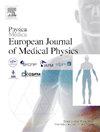10B 中子俘获增强粒子疗法中硼中子俘获识别屏蔽策略的探索性研究。
IF 3.3
3区 医学
Q1 RADIOLOGY, NUCLEAR MEDICINE & MEDICAL IMAGING
Physica Medica-European Journal of Medical Physics
Pub Date : 2025-01-01
DOI:10.1016/j.ejmp.2024.104866
引用次数: 0
摘要
目的:评估一系列屏蔽策略对中子俘获增强粒子疗法(NCEPT)中模拟探测器误报率的影响:在这项工作中,我们扩展了以前公布的中子俘获检测和分辨方法。我们设计了一个 Geant4 蒙特卡洛模型,用碳离子束和氦离子束以及各种屏蔽配置模拟辐照聚甲基丙烯酸甲酯模型和立方体 10B 插入物:在自由空间配置中,对晶体进行屏蔽实际上会使真/假阳性检测率(RTF)降低 50%以上,并提高探测器的活化率。在采用光束线中子通量模型的封闭空间配置中,RTF 也会随着屏蔽而降低,尽管在这种情况下活化也会降低。然而,对于印刷电路板(PCB)中含有硼的探测器,使用一薄层 Gd2O3 进行屏蔽可将 RTF 提高 21%:结论:没有必要对探测器晶体本身进行屏蔽,因为与未屏蔽的探测器相比,屏蔽实际上会降低分辨精度。但是,如果探测器的印刷电路板中含有硼,那么对电子元件进行屏蔽可有效提高探测器的整体选择性。本文章由计算机程序翻译,如有差异,请以英文原文为准。
An exploratory study of shielding strategies for boron neutron capture discrimination in 10B Neutron Capture Enhanced Particle Therapy
Purpose:
To evaluate the impact of a range of shielding strategies on the rate of false positive detections by a simulated detector for application in Neutron Capture Enhanced Particle Therapy (NCEPT).
Methods:
In this work, we extend a previously published method for neutron capture detection and discrimination. A Geant4 Monte Carlo model was designed, with the simulated irradiation of a poly(methyl methacrylate) phantom and cubic 10B insert with carbon and helium ion beams and various shielding configurations.
Results:
In the free-space configuration, shielding the crystal actually decreases the ratio of true/false positive detections () by more than 50% and increases the activation of the detector. In a closed-space configuration with a model of the beamline neutron fluence, also decreases with shielding, although activation decreases in this case. However, for a detector with boron present in the printed circuit boards (PCBs), shielding with a thin layer of GdO improves by up to 21%.
Conclusions:
Shielding of the detector crystal itself is unnecessary as shielding actually degrades discrimination accuracy relative to the unshielded detector. However, if the detector PCBs contain boron, then shielding the electronics provides a valuable increase in overall detector selectivity.
求助全文
通过发布文献求助,成功后即可免费获取论文全文。
去求助
来源期刊
CiteScore
6.80
自引率
14.70%
发文量
493
审稿时长
78 days
期刊介绍:
Physica Medica, European Journal of Medical Physics, publishing with Elsevier from 2007, provides an international forum for research and reviews on the following main topics:
Medical Imaging
Radiation Therapy
Radiation Protection
Measuring Systems and Signal Processing
Education and training in Medical Physics
Professional issues in Medical Physics.

 求助内容:
求助内容: 应助结果提醒方式:
应助结果提醒方式:


